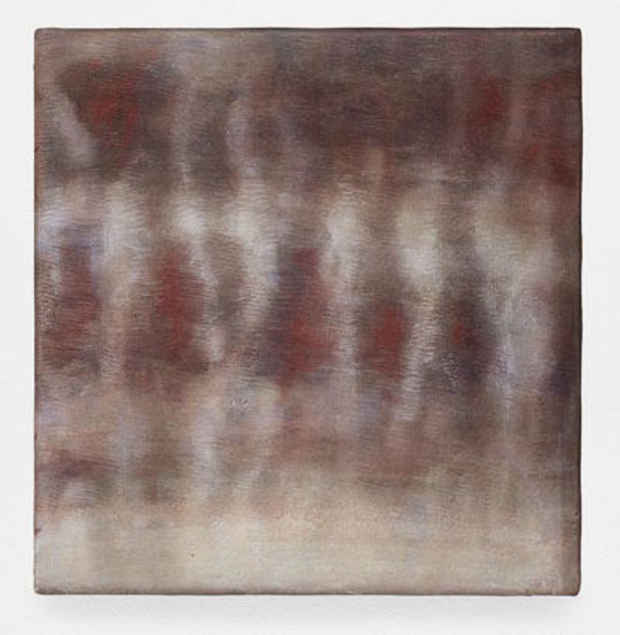Bracha L. Ettinger Exhibition
Callicoon Fine Art

This event has ended.
Callicoon Fine Arts presents a solo exhibition of paintings, works on paper and notebooks by Bracha L. Ettinger. The exhibition follows her participation in the 14th Istanbul Biennial this past autumn and marks a return to New York since her presentation of The Eurydice Series at the Drawing Center in 2001.
In Bracha’s paintings resonant striations of color, most often blues, violets and reds, are formed from an accumulation of thin lines of oil paint made over several years on each single canvas. Light filled vertical forms are figures simultaneously created by and fused with these horizontal striations. They undulate across the works, screens of intimate size, joining transparent layers of luminosity to shadow, revealing each painting as a space of connectedness and transformation, charged with historical trauma.
This reaching between light and dark is thematically articulated in the titles of the works by reference to Eurydice and Medusa, among other figures from mythology and literature. Take for example paintings in the exhibition such as Eurydice nu descendrait (no 1) and Eurydice, The Graces, Medusa: mythological yet still enigmatic figures associated with the feminine, they act to bridge unconscious and historical memory, seeking paradoxical associations between catastrophe and transcendence.
The earliest works from The Eurydice series, seen in New York at the Drawing Center, contained fragments of photographs from genocidal Europe of 1942 showing women, mothers and children about to be executed. The photographs have been passed through an interrupted photocopier, making their traces spectral and ghostly. These altered images were then mounted to canvases to become one of the sources of the oil paintings.
In some of the more recent work, like Eurydice, the Graces, Medusa and No Title Yet (no 2) presented here, leftovers of such fragmented images are printed directly onto the canvas, appearing and disappearing along with an intensification of the abstract working-through with oil. Like Eurydice descending into the underworld, the image-figures confront their own disappearance, sliding on the color-lines as they dissolve into light and shadow, re-emerging, if only partially, as lively substance.
Within this meeting of figurative traces and an abstract research concerning mental visions, the ethical and healing potential of Bracha’s artworks begins to reveal itself. While the works are not abstractions of the devastating historical images, they shuttle abstract “thought-forms” (as revealed by 19th century theosophists) through to the images. For Bracha, abstraction that begins from the mind, enacts from the painting itself a healing transformation that confronts the most difficult atrocities in reality, like that of the Holocaust. Between these incommensurable levels there is an aporia that finds expression in the various dimensions — of history, of the psyche — that coexist within each artwork.
Petals, rhizomes, bark, ligaments and veins are some of the visual motifs that appear in the works on paper, also shown here. The series, And my heart wound-space with-in me and Chrysalis, show compressed spaces of emergence surrounded by glowing auras in twining folds of transparent color, while the double sided “Lichtenberg Flower and Medusa” works further elaborate the visual vocabulary.
The notebooks, large in number, are a kind of archive incorporating handwriting in French, Hebrew and English that is enmeshed with drawing and doodles, quick jottings bumping against longer elucidations and quotidian necessities. Question marks, strings, arrows, tumbling figures, scattered sensations and thoughts, and notes that express the evolution of her philosophical and psychoanalytical thought, constantly reset the core of Bracha’s idiosyncratic practice.
Bracha L. Ettinger (b. 1948 in Tel Aviv) is a painter who works between Paris and Tel Aviv. She participated in the recent 14th Istanbul Biennial, 2015, where a large room was devoted to her work in various media. Additional significant solo exhibitions include the Musée des Beaux-Arts d’Angers; Casco, Utrecht; Fundació Antoni Tàpies, Barcelona; Freud Museum, London; BOZAR – Palais des Beaux-Arts, Brussels; Israel Museum, Jerusalem; Musée des Beaux-Arts, Calais; MoMA, Oxford; Le Nouveau Musée, Villeurbanne; Museum of Art, Pori; and The Drawing Center, New York. Group exhibitions include the Museum of Modern Art, Warsaw; elles@centrepompidou, Centre G. Pompidou, Paris; ARS06 Biennial, KIASMA Museum, Helsinki; Face à l’Histoire, Centre G. Pompidou, Paris; Inside the Visible, ICA, Boston, National Museum for Women in the Arts, Washington, Whitechapel, London, Art Gallery of New South Wales, Sydney; Villa Medici, Rome; and Kabinet, Stedelijk Museum, Amsterdam. Several monographs are devoted to her work and thought, and her paintings are in the collections of Castello di Rivoli, Torino; Centre Pompidou, Paris; Haifa Museum of Art, Israel; Musée des Beaux-Arts d’Angers, France; Tel Aviv Museum of Art, Israel, and more.
Also a psychoanalyst, Bracha L. Ettinger is one of the world’s leading theorists in the realm of sexual difference and French feminism, whose writings have influenced film and literary thinking, queer studies, aesthetics, ethics, psychoanalysis and art history. Among other academic positions, she is the Marcel Duchamp Chair and Professor in Media and Communication, European Graduate School, Saas-Fee; and an activist with Physicians for Human Rights. Bracha is the author of many articles and books including Matrix. Halal(a) – Lapsus. Notes on Painting 1985-1992 (MOMA Oxford 1993) and The Matrixial Borderspace (Univ. of Minnesota Press 2006).
Media
Schedule
from March 24, 2016 to April 24, 2016
Opening Reception on 2016-03-24 from 18:00 to 20:00